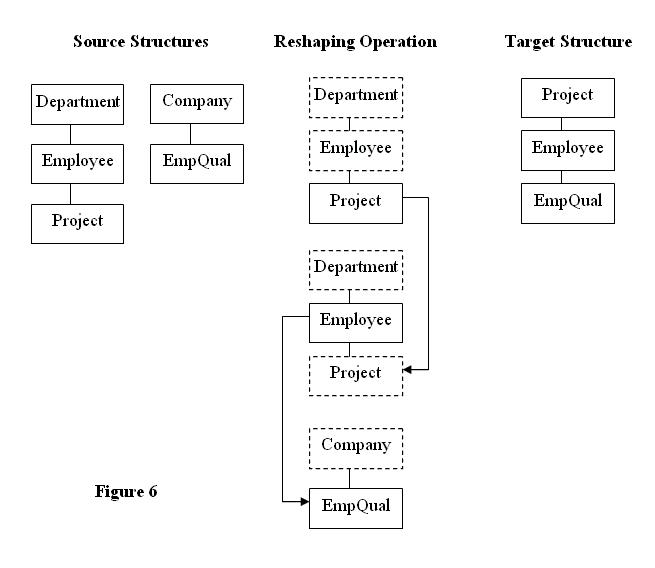|
Trends
Logic in DB
Drivers
ODBC
JDBC
OLE DB
.NET
Podcast
SQL:2003
MS SQL 2005
Webcast
SQL:2003
MS SQL 2005
|
|
<<Prev 1 2 3 4 5 6 7
Multi-type and Multiple Structure Transformation
Restructuring structure transformations can be performed using multiple input structures, they are not limited to a transform consisting of a single source structure. The target structure can be constructed from fragments of multiple source structures. It is also possible that both Restructuring and Reshaping operations can be applied in the same structure transform operation. Depending on how closely the result resembles a Restructure or Reshape operation, it may be safest to refer to the transform generically as a structure transform. The example structure transformation in Figure 6 uses multiple source structures (Department and Company) and both Restructuring and Reshaping operations. Reshaping inverts the Department and Employee nodes and Restructuring is used to relate employees in the Department structure to their qualifications in to the Company structure.

Additional Advanced Examples Available
|
 Fast, reliable data access for ODBC, JDBC, ADO.NET and XML Fast, reliable data access for ODBC, JDBC, ADO.NET and XML
|
My company, Advanced Data Access Technologies, Inc. has developed an ANSI SQL transparent native XML hierarchical processor, SQLfX®, that handles relational and XML integration at a full nonlinear hierarchical processing level. It handles the restructuring and reshaping shown and described in this article as well as full hierarchical structure joining and advanced hierarchical processing capabilities. Notably, these capabilities are performed in ANSI SQL fully non-procedurally and hierarchically correct. To locate a pointer to these SQLfX® Beta examples check out our site’s home page at www.adatinc.com.
|
Conclusion
There are two basic methods of performing structure transformations today and this article has shown the difference between these two structure transformations. Unfortunately, the terms Restructure and Reshape both apply to each of the basic structure transformations. It is important to understand the difference between these two structure transformations and assign them different distinguishable terms. This article has used a distinguishable terminology using the same two structure transformation terms that seems to make the most sense. Reshaping uses the structure’s semantics to transform the structure and its data, it does not use data relationships. This is useful for transforming a data structure to any desired structure. Restructuring uses data relationships to transform the structure. This is used to match a data structure to its intended application use. These methods can also support supplemental transformation capabilities such as renaming, splitting and duplicating nodes in transformation operation.
<<Prev 1 2 3 4 5 6 7
Database Server Watch SQL Summit Home Page Articles

© 2007, Ken North Computing LLC, All rights reserved.
|
|

|